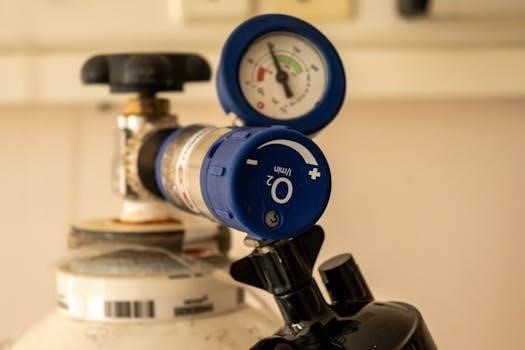Honeywell Gas Control Valve Manual⁚ An Overview
This manual provides a comprehensive understanding of Honeywell gas control valves. It covers their use in gas-fired appliances, incorporating safety features, automatic operators, and pressure regulators for optimal performance and safety.
Honeywell gas control valves play a crucial role in regulating gas flow within heating equipment and various gas-fired appliances. These valves incorporate safety shutoff mechanisms, manual controls, and automatic operators, ensuring efficient and safe operation. The valves are designed to manage gas flow, pressure, and ignition sequences in diverse applications. Honeywell offers a wide range of gas control valves tailored to specific system requirements. Understanding their function and features is essential for proper installation, maintenance, and troubleshooting in residential and industrial settings. Proper handling ensures both optimal performance and safety standards are adhered to.
VR8205 and VR4205 Series⁚ Direct Ignition Valves
The VR8205 and VR4205 series gas controls are designed for direct ignition systems in gas appliances. They include a safety shutoff, manual valve, automatic operators, and pressure regulator features.
Features of VR8205 and VR4205 Gas Controls
The VR8205 and VR4205 series offer several key features for gas-fired appliances using direct ignition systems. These controls incorporate a safety shutoff mechanism, ensuring safe operation by halting gas flow in case of ignition failure. They also include a manual valve for user control and two automatic operators for regulating gas flow during operation. Furthermore, a pressure regulator maintains consistent gas pressure, while the VR4205 includes a conduit cover. These valves are compatible with S89C, E, F, and S87 series 5 and later.
V800 Family of Combination Gas Controls
The V800 family of gas controls performs essential functions in gas-fired heating equipment. They offer reliable burner manifold control, suitable for various domestic appliances, ensuring efficient gas flow management.
Capacities and Applications of V800 Valves
The V800 series offers seven capacity ratings, making them suitable for diverse applications, from individual room heaters to central heating units. These combination gas controls provide a 3-position manual control (OFF-PILOT-ON) for gas flow. The Class A servo-regulated valves are designed for gaseous fuels in gas-consuming appliances, adhering to international standards. The main body features two shut-off valves with a single seat, ensuring safety. Options include flanged minimum and interim pressure switches, enhancing operational control. The valve’s closing time is less than one second, providing rapid response capabilities. These intermittent pilot gas controls accommodate capacities up to 415 ft3/hr.

V4062A/B/D HI-LO-OFF Gas Valve Actuators
The V4062A/B/D series includes gas valve actuators designed for HI-LO-OFF operation. Models vary, including high-pressure options and proof-of-closure switches, providing versatile solutions for gas control applications.
Use Cases with V5055/V5097C,E Gas Valves
The V4062A/B/D HI-LO-OFF gas valve actuators are designed for use with V5055 and V5097C,E (double seal) gas valves. These combinations are often implemented in systems requiring valve seal overtravel interlock, enhancing safety and reliability. These actuators should not be used with the V5034 valve body. The V5055 and V5097 series gas valves are often selected for industrial applications demanding robust shut-off performance; V4055 fluid power actuators can be used in conjunction with the V5097 series gas valves.

V4943/V8943B,C,N and V4944/V8944B,C,L,N Regulating Diaphragm Gas Valves
These regulating diaphragm gas valves are suitable for natural or liquid petroleum (LP) gases. They are used in applications such as boilers, unit heaters, and rooftop heaters, ensuring precise gas regulation.
Sizing and Application for LP Gas Systems
Proper sizing is crucial when using V4943/V8943 and V4944/V8944 series valves in LP gas systems to ensure optimal performance and safety. Selecting the correct valve size involves considering the required gas flow rate and pressure drop. Refer to capacity charts that indicate flow rates for different valve sizes at specific pressure drops. For instance, you can find capacity versus pressure drop curves for 1-1/4 inch, 1-1/2 inch, and 2-inch valves. For systems with two identical valves piped in series, consult relevant sizing guidelines to ensure accurate and safe operation.
VK41../VK81.. Series Gas Controls
The VK41../VK81.. series gas controls are designed for combined valve and ignition systems; These controls work with dedicated ignition controls like the S4565/S4575/S4585 series, enhancing system integration and performance.
Integration with Ignition Systems S4565/S4575/S4585
The VK41../VK81.. series gas controls are uniquely designed for seamless integration with Honeywell’s S4565, S4575, and S4585 ignition systems. This combination creates a comprehensive control valve and ignition solution, optimizing performance in various gas-fired applications. The direct connection ensures reliable ignition and efficient gas control, enhancing overall system safety and responsiveness. By using specified rectifier plugs, the VK4105 series valves can be used with any standard ignition system, increasing adaptability.
Installation and Replacement with Gas Valve Replacement Kit
The gas valve replacement kit facilitates safe and efficient installation of Honeywell VR8205 series gas valves. It includes step-by-step instructions for experienced technicians, ensuring compliance with local codes and proper connections.
Step-by-Step Guide and Safety Precautions
Replacing a Honeywell gas valve requires careful adherence to safety protocols and a systematic approach. First, shut off the gas supply and disconnect electrical power; Consult the valve’s manual for specific instructions tailored to your model, such as the VR8205 series.
Carefully remove the old valve, noting the orientation of connections. Install the new valve, ensuring proper gas and electrical connections, and leak-test all fittings with soapy water. Refer to the replacement kit instructions, and always prioritize safety during the exchange. Verify the valve’s correct operation after installation.

Troubleshooting and Maintenance
Address common issues in Honeywell gas valves through systematic troubleshooting. Regular maintenance, as outlined in the manual, ensures longevity and safe operation. Always prioritize safety and consult professionals when needed.
Common Issues and Solutions
Addressing problems such as the pilot light not staying lit, or the main burner failing to ignite, requires careful diagnosis. Check the gas supply, thermocouple, and pilot assembly for obstructions or damage. Ensure proper electrical connections and verify the valve’s mechanical operation. A faulty pressure regulator might cause inconsistent flame. Also, inspect for gas leaks around valve connections. If problems persist, consult a qualified technician for gas valve replacement or further diagnostics to ensure safe and efficient appliance functionality, following all safety protocols.
Compatibility and Cross-Reference Information
This section facilitates identifying compatible Honeywell gas control valve models. It helps find suitable replacements, ensuring proper fit and function. Cross-referencing helps maintain system integrity and safety standards.
Finding Suitable Replacement Parts
Locating the correct replacement parts for Honeywell gas control valves is essential for maintaining the efficiency and safety of gas-fired appliances. This involves cross-referencing the original part number with available alternatives, considering factors like gas type (natural or LP), capacity, and connection sizes. Understanding the valve’s specifications ensures compatibility. Utilizing resources like technical literature and online databases can significantly aid in identifying the appropriate replacement, preventing potential hazards and ensuring optimal performance. Proper identification ensures that the new component meets the required safety standards and functional demands of the system.

Manuals and Technical Literature
Accessing official Honeywell documentation is crucial for understanding gas control valves. Manuals, datasheets, and technical literature provide detailed specifications, installation guides, troubleshooting tips, and safety precautions for proper usage.
Accessing Official Honeywell Documentation
To ensure safe and effective use of Honeywell gas control valves, accessing the official documentation is paramount. Honeywell provides comprehensive manuals, installation guides, and technical specifications. These documents detail valve operation, troubleshooting, and maintenance procedures. They also provide crucial safety guidelines and regulatory information. Accessing these resources is essential for qualified technicians and installers. Check the Honeywell website for the latest versions of manuals, datasheets, and other relevant technical literature. Proper understanding of these documents can prevent accidents and ensure optimal performance of the gas control system.